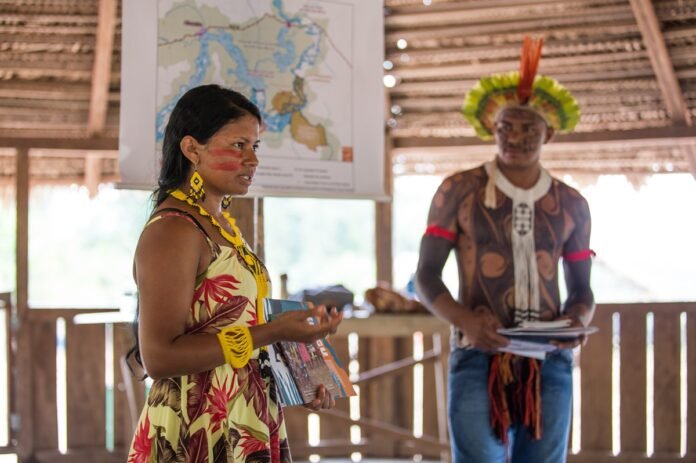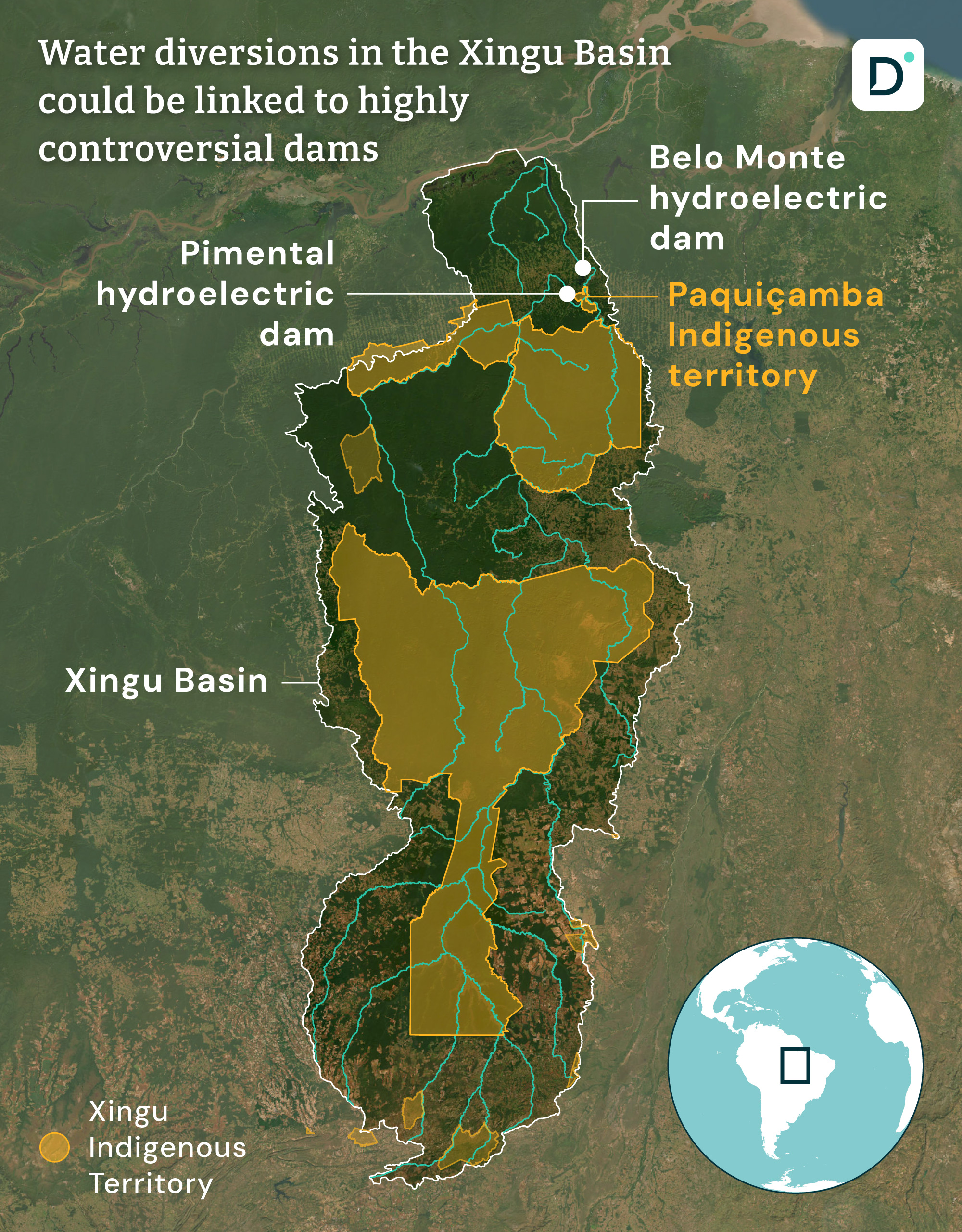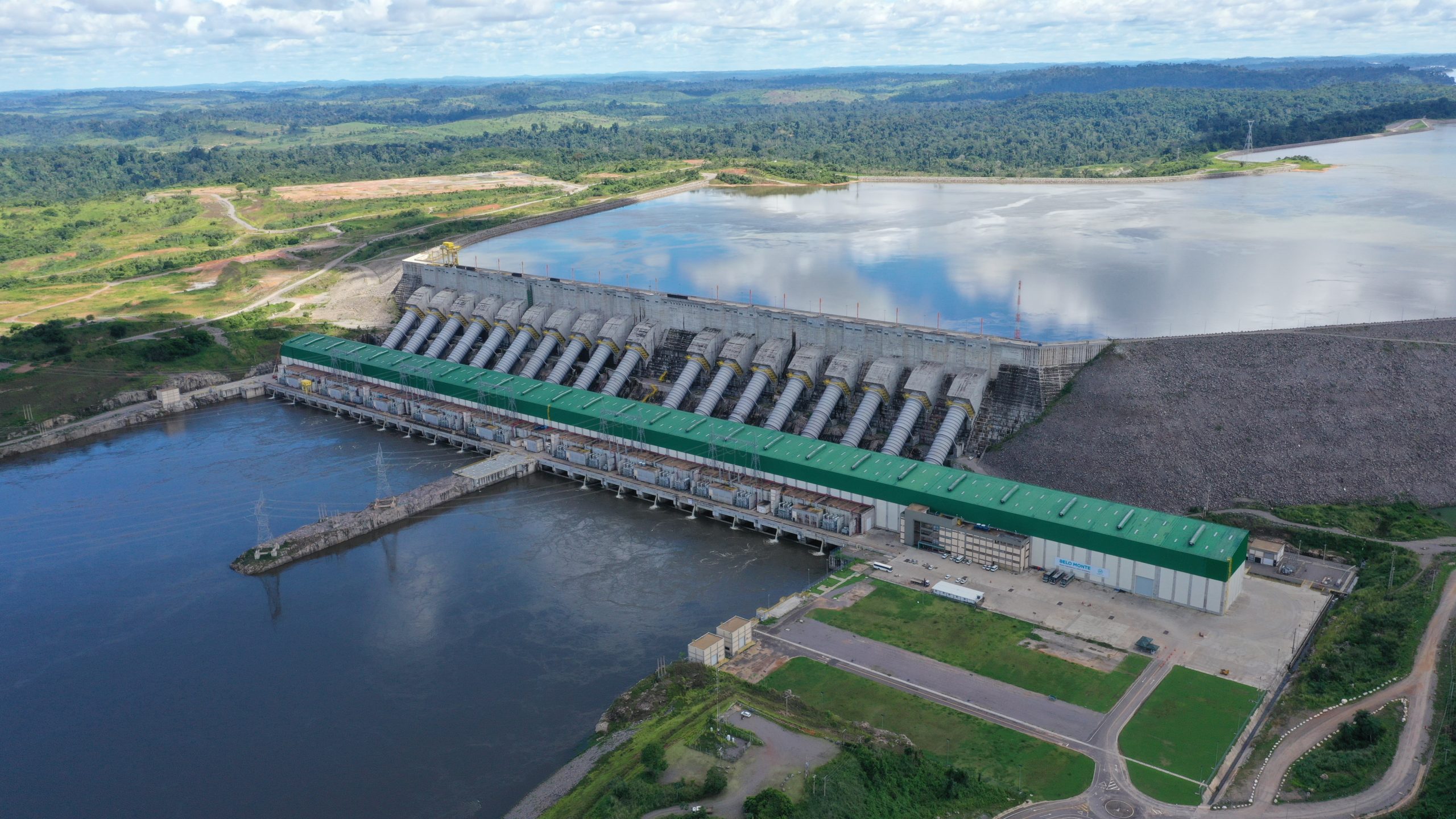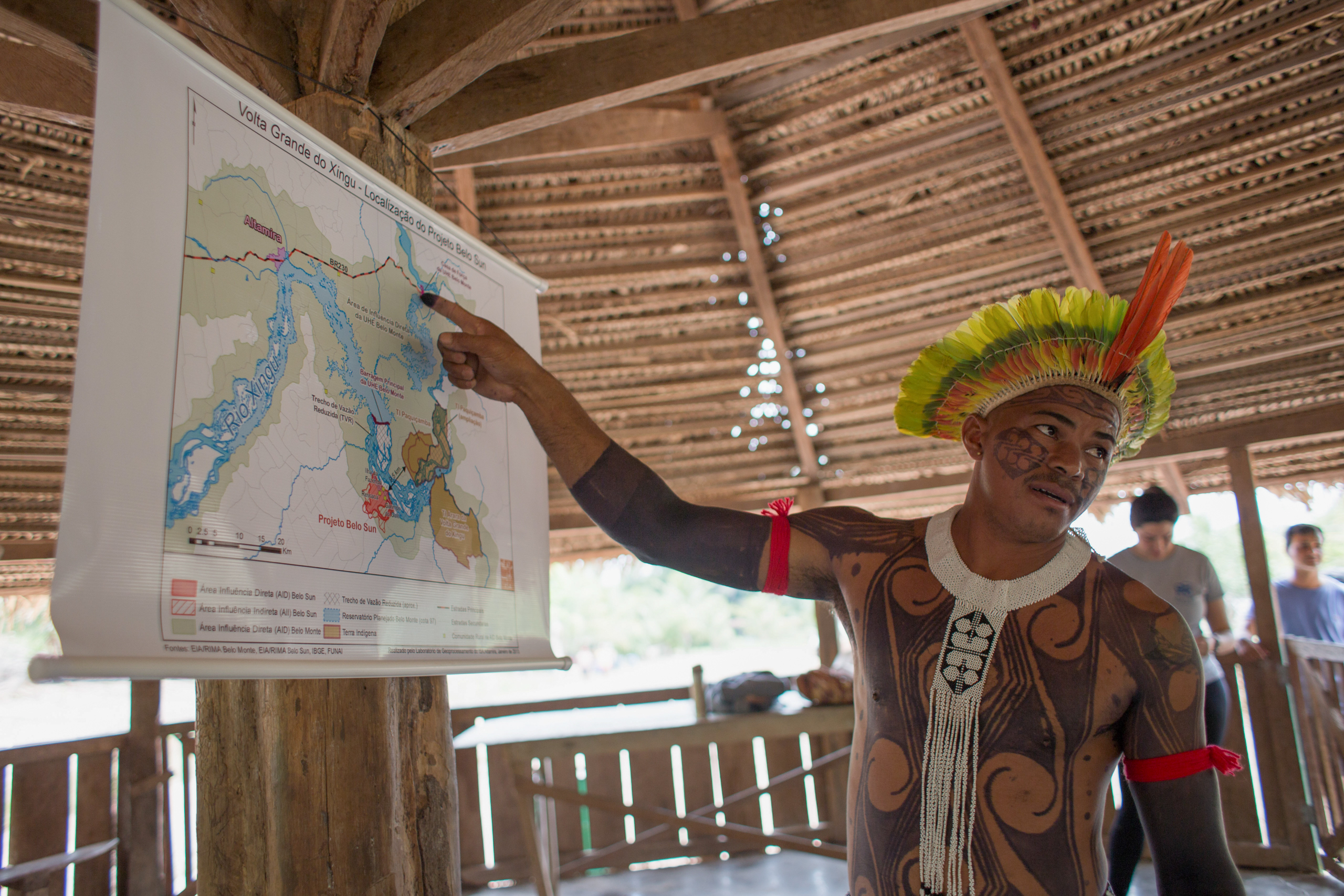An Indigenous Brazilian community is taking on the company behind one of the world’s biggest hydroelectric plants over the impacts of its dams on the environment and livelihoods.
A community-led study alleges the Belo Monte plant, which opened in 2016, is responsible for disruption to rivers, fish and those who rely on both. Academics who took part in the research say the dams’ prevention of flooding is destroying local ecosystems, but the company responsible is strongly defending its record.
Belo Monte’s two dams have triggered decades of controversy, due to their installation in a sensitive rainforest ecosystem in the Amazonian state of Pará. They divert much of the Xingu River’s natural flow into an off-channel reservoir that feeds the main powerhouse. This includes reducing the flow of a 130km stretch known as the Volta Grande do Xingu (VGX or “Big Bend”).
The Juruna/Yudjá people are an Indigenous population who have inhabited the islands and peninsulas of the lower and middle Xingu River for centuries, using canoes to navigate the area and to hunt. The Belo Monte project has compelled the Juruna/Yudjá, along with other small-scale fishing communities and an array of specialist researchers, to collaboratively track flood cycles and fishing habitats along the VGX.
At the end of May, the results of this monitoring programme were published in Conservation Biology, a peer-reviewed scientific journal. It was co-authored by a team of 32, who concluded that water diversions caused by the dams have caused permanent drought-like conditions, devastating fish spawning and consequently the catch of local fishers. They documented drastic changes to traditional lifestyles and fishing practices.
“Because we live here, we were born here, we grew up here; we know the region very well. So, if anything changes, we notice it very quickly,” says Josiel Jacinto Pereira Juruna, the report’s lead author. He is also the vice-leader of Miratu, a village of around 90 people on the Xingu’s west bank. “Our elders warned us that over time this would happen. And once the dam opened, it did.”
These riverside communities say they are no longer able to depend on the river’s natural flooding cycle.
Distrustful of the official impact assessments produced by the dam operators, members of the communities have been conducting independent research since 2013. As part of these efforts, Juruna co-created an organisation, the Independent Territorial Environmental Monitoring of the VGX (MATI-VGX), in 2022.
Norte Energia, the private consortium that built and operates the dams, disputes many of the claims made in the study. It argues the dams “do not promote drought in the Xingu”. It also insists that changes documented by the researchers were considered before construction began and are being dealt with.
It told Dialogue Earth: “The monitoring carried out by MATI-VGX, despite having relevant methodological gaps, has indicated changes that were already foreseen in the environmental licence and for which Norte Energia is developing mitigation and compensation actions.” Norte Energia did not elaborate on these methodological gaps.
Waiting for the floods
The community monitoring programme installed water-level gauges at nine piracema sites. These are the seasonally flooded habitats that are crucial for fish reproduction, feeding and shelter. The stations followed protocols used by Brazil’s National Water Agency (ANA), as part of a drive to combine scientific rigour with local ecological knowledge about fish behaviour and spawning.
“The monitoring is done daily or weekly, by the local monitors, who are Indigenous people and riverside dwellers who live in the affected region,” says Camila Cherem Ribas, a senior researcher at the National Institute for Amazonian Research (INPA) in Manaus, and a co-author of the paper.
It is forbidden to flood Indigenous land, but drying out Indigenous land is not in that law
Camila Cherem Ribas, a senior researcher at the National Institute for Amazonian Research (INPA) in Manaus
In natural conditions, the South American monsoon system triggers river flooding that begins in November. Many fish begin to spawn in December, when water levels reach critical thresholds. The Conservation Biology paper says the dams’ water diversions delay this flooding by between one and four months.
According to the research, at one piracema near Zé Maria Island, fish require water levels of at least 103cm to enter spawning areas. This level was not reached until February in 2022 and April in 2023 – long after the natural spawning season should have begun. The paper argues that these delays either prevent spawning entirely, or cause fish eggs and larvae to die due to insufficient water, food availability and shelter.
“It is forbidden to flood Indigenous land, but drying out Indigenous land is not in that law,” says Ribas. “These environments have unique characteristics and depend on the flooding cycle. So, the lack of flooding starts to kill the environment. The Indigenous people clearly noticed this.”
Norte Energia’s statement says its own studies with local fishers have identified 140 existing piracema areas in the Volta Grande do Xingu: “As foreseen in the environmental impact assessment, a large part of these areas will be flooded at the start of the season, guaranteeing suitable conditions for the reproduction of many species. Furthermore, it is important to note that several species of fish do not depend on the piracemas to reproduce.”
Catching less
This disruption of the flooding affects the broader ecosystem, according to the communities’ research. Most trees in seasonally flooded forests typically synchronise their fruiting with rising water levels, providing crucial food for aquatic animals and allowing their seeds to be dispersed by fish. When flooding is delayed, fruits fall before water arrives, breaking this essential ecological connection and reducing food availability for fish and other aquatic animals.
“[The locals] not only collect the data, they also decided what needed to be monitored, what the strategies should be,” explains Ribas. “When they decided what should be monitored, they had much more ecological vision than traditional scientific monitoring, which is very compartmentalised in western science.”
No fish species have become extinct in the areas of influence of the project
Norte Energia
Fishing yields in local communities also saw a dramatic decline. The researchers compared data collected by Norte Energia before the dam was operational (2001-2008) to the communities’ post-dam data (2020-2023). The overall catch per unit effort figure dropped from 11.1kg per fisher per day before 2009 to 4.53kg from 2020.
Catch per unit effort (CPUE) is a metric used in fisheries science to try and establish fish abundance in a given location. It measures how much effort is required to catch a certain amount of fish. Fish can be measured by number or weight, while effort is measured depending on the fishing technique. For example, fish caught per 1,000 hooks per day or per hour of trawling.
Average catches plummeted. Pescada (Plagioscion) catches dropped from nearly 100kg per fishing trip to 1.66kg, whilst curimatá (Prochilodus nigricans) declined from 68kg to 5.4kg.
The composition of catches changed significantly. Tucunaré (Cichla), a large fish native to the Amazon, previously made up 29% of catches. This has fallen to just 5.5%, according to the community monitoring data.
These changes forced adaptations in fishing practices. For example, instances of gillnet catches among the Altamira commercial fleet, representing the primary city in the area affected by the dams, increased from 22% to 47%.
A vertical wall of netting kept upright by floats and weights. The mesh size of gillnets are chosen depending on the target species, though bycatch is a recurrent problem. Gillnets are used all over the world in both small- and large-scale fisheries.
Meanwhile, hook-and-line fishing declined from 47% to 35%. Gillnets are often reported to be a less sustainable fishing method than hook-and-line, due to the amount of non-target species they can inadvertently snare.
Norte Energia says: “Most species have maintained the proportion of mature fish over 13 years of study in the Volta Grande do Xingu region. Some species had changes in their reproduction pattern, a scenario foreseen in the project’s environmental impact assessment. However, no fish species have become extinct in the areas of influence of the project.”
“Many of the harms of Belo Monte were underestimated in the formal [environmental impact assessment],” counters Eve Bratman, a professor of environmental studies at Franklin and Marshall College in the US. She was not involved in the Conservation Biology paper.
“Scholarly researchers and community members had completely predicted that the dam would be an ecological disaster as well as a social tragedy,” she adds. “It was absolutely preventable, had the government and its contractors done a better job of listening to civil society voices from the get-go.”
Monitoring and mitigation
The communities’ study proposes specific criteria for a new operational framework for the power plant and the region. It balances energy production with ecological respect. For example, matching the river’s dam-controlled water levels to fluctuations that would have occurred naturally, supporting fish migration and synchronising flooding with the natural fruiting periods of riverine vegetation.
Both the local researchers and their academic colleagues say policy change is necessary. Hydropower is presented as a green option, vital to reducing fossil-fuel emissions, and Belo Monte is estimated to represent around 5% of Brazil’s electricity-generation capacity. But the researchers say their study shows hydropower has consequences that are often neglected.
“In the Amazon, at least, hydroelectric energy is not clean energy,” says Ribas. “The environmental and social costs are very high. The Amazon depends on the flood cycle and dams, by nature, interrupt it. We think a change in the sharing of water in the Volta Grande is the only option.”
Norte Energia strongly defends its project’s environmental credentials:
“The amount of water earmarked for the Volta Grande do Xingu was studied and established by the Brazilian government as part of the concession auction [for the dams] and is an integral part of the environmental licensing process. The current model was developed based on 11 different hydrological scenarios evaluated in the environmental impact assessment and is an environmental mitigation measure, with the aim of ensuring, among other things, the flooding of the piracema areas and the maintenance of the river’s ecological cycles.”
Norte Energia says its monitoring meets the criteria established by Brazil’s environmental regulator, the Brazilian Institute of the Environment and Renewable Natural Resources (Ibama). Furthermore, the consortium says its research has resulted in 36 scientific articles in national and international journals and 39 abstracts presented at academic conferences.
Norte Energia says it has taken mitigatory action including compensation to protect and maintain reproductive and feeding sites for fauna; setting up ecology and fish-reproduction laboratories; restoring vegetation to maintain reproduction and feeding environments; strengthening subsistence production actions with riverside families and fishers; and improving water supply and sewage systems. The company says its socio-environmental investments in the region total BRL 8 billion (USD 1.4 billion).
Ibama, meanwhile, tells Dialogue Earth that it “continuously monitors compliance with the environmental conditions established in the Belo Monte hydroelectric power plant licence” by “monitoring data generated by the programmes provided for in the licensing process”.
Ibama continues: “To date, the aforementioned document and the data produced by the MATI-VGX Programme have not been included in the records of the Belo Monte hydroelectric power plant licensing process, which makes it impossible for Ibama to make any technical statement.”
Integrating traditional knowledge
Whatever happens with Belo Monte’s piracema sites, the researchers hope their collaborative model for monitoring them will spread.
Juruna says he hopes this partnership of riverside communities, Indigenous people and scientists can become a reference for other studies, to show that science can incorporate the local knowledge of traditional peoples.
Beyond this, Juruna hopes for national solidarity:
“We cannot abolish Belo Monte, but we can at least share the water. People in the large cities that receive this energy need to understand we live here, too. We are human beings, we need to have a life. We cannot destroy this biome just to benefit one part of society and forget the other parts. Because that other part of society is suffering.”
Dialogue Earth also contacted Brazil’s Ministry of Mines and Energy to comment on the issues raised in this article but did not receive a response.









